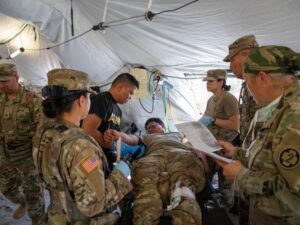
Story by Spc. Midori Preecs
Exercise News Day
FORT HUNTER LIGGETT, Calif. — Soldiers face various challenges when training in field environments, whether it’s sleep deprivation or the chaos of stressful events. Soldiers also face real-world challenges related to medical readiness. These challenges include maintaining physical health, managing injuries, and ensuring quick access to medical care.
“Some of the most common issues we see include heat illness, respiratory illness, allergies, and wildlife interference such as snake or spider bites,” said Capt. Andrea Hook with the 7402nd Troop Medical Clinic. “We are here to support the larger Combat Support Training Exercise, but also to provide real-world medical assistance to all Army Reserve units that are here training in the mass operation.”
Making sure there are medical aid stations available to Soldiers during their training is significant to the overall success of the exercise.
“In addition to the main clinic here, we do have providers and medics on a smaller scale at the tactical assembly areas with the Soldiers in the field at the point of injury,” said Hook.
Having these designated locations is important, but ensuring qualified individuals can provide treatment and determine whether a Soldier needs further medical aid is paramount.
“We have three to four Medical aid stations operating at a time, with one to two providers and medics at each location,” said Hook.
Having providers on ground with the Soldiers makes receiving the medical care needed more efficient. They can authorize more treatment or route Soldiers to where they can receive urgent care.
Hook said, “If it is deemed that they need a higher level of care, we can contact emergency medical services through Fort Hunter Liggett dispatch and have them sent over to the local hospital.”
At CSTX 24-01, approximately 5,000 Soldiers are on ground at Fort Hunter Liggett, and approximately 950 have experienced real-world medical injuries or illnesses. This is almost 20% of the Soldiers participating in the exercise.
“Checking on your battle buddies and asking how they are doing, or making sure they are eating and drinking water, is one of the biggest helps. We can’t be everywhere all at once, so looking out for each other is crucial,” said Hook.
With immediate access to medical care, Soldiers can train more effectively and confidently, knowing that their well-being is prioritized.
Enduring these real-world elements while training helps Soldiers prepare for the complexities of actual combat situations, making them more resilient and capable in the face of adversity.